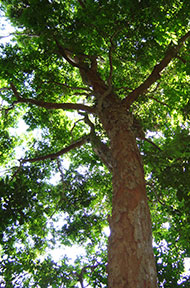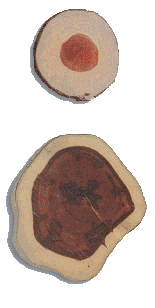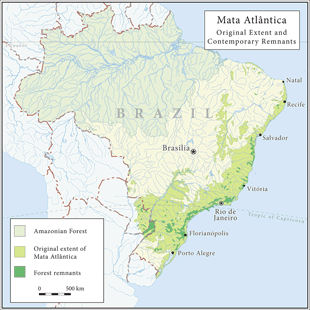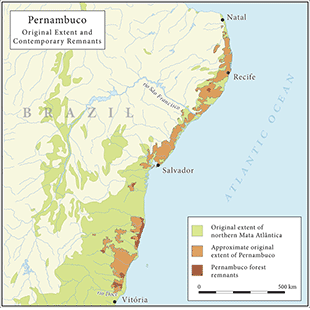About Pernambuco

The International Pernambuco Conservation Initiative (IPCI) was created out of concern for pernambuco (Caesalpinia echinata), a species of tree native to Brazil’s Mata Atlântica, or Atlantic Forest. Following the discovery of the Americas by Europeans, pernambuco, which is also known as pau-brasil, was commercially harvested and imported to Europe for dye making. As a result of this intense exploitation, pernambuco was already in steep decline by the 18th century, when François-Xavier Tourte recognized the exceptional qualities of its heartwood for bow making.
Today, more than 250 years after Tourte first made pernambuco a popular choice for bow sticks, no comparable substitute is known to bow makers or musicians. The rigidity, flexibility, density, and beauty of this wood, combined with its ability to hold a fixed curve, makes pernambuco a unique material that is essential to the craft of bow making and to the musicians who use these bows.
The Material for Bow-Making

Previously, lighter-density European woods or other tropical woods had been used by bow-makers. Some of the tropical woods, such as massaranduba, snakewood, and Swartzia, were referred to as “ironwoods” owing to their remarkable density and hardness. Within a short time, pernambuco replaced all these other woods because the quality of sound it produced was much favoured by musicians and because its physical qualities make it an ideal material for crafting cambered bow-sticks.
Pernambuco is a slow-growing, medium-sized tree of the Leguminosae family. Its heartwood varies from orange brown to reddish brown or dark wine red, and darkens upon exposure to light after the tree is cut. This coloration is distinctly different from the whitish or yellowish beige of the sapwood.
The tree does not begin to produce the hard dark heartwood for which it is renowned until it is 10 years old and the heartwood only becomes dominant after 20 years. A reforestation program in the state of Pernambuco has shown that a properly pruned and cared-for tree will produce heartwood suitable for bow-making in thirty to thirty-five years as opposed to the 80 to 100 years required for a tree in the wild.
An Endangered Species in an Endangered Habitat
The pressures on contemporary pernambuco stocks are by no means due exclusively to demands for the wood itself. Over the past 500 years the Mata Atlântica has undergone drastic shrinkage as a result of the progressive conversion of land to farming and urban development. Map 1 shows the pre-Columbian extent of the Mata Atlântica and the current remnants – approximately 8% of the original area – of this forest.
Discussions of the pernambuco habitat usually equate its erosion with that of the entire Mata Atlântica, due to a misconception that pernambuco was originally found throughout the Atlantic Forest region. However, the shrinkage of the pernambuco habitat is significantly more serious than that of the Mata Atlântica in general. Even in pre-Columbian times pernambuco grew only in very restricted areas where the right combination of climatic and soil conditions were present: the northern part of the region, within 100 km of the coast, from the Rio Dolce (just north of Vitória) up to Natal. Map 2, an enlargement of this area, shows the original Mata Atlântica, the original extent of pernambuco habitat (based on contemporary soil and vegetation data), and the current pernambuco forest.
These remnants constitute less than 5% of the original growth of what was never more than a small fraction of the Mata Atlântica as a whole. Because of this drastic reduction, pernambuco has recently been added to Appendix 2 of the Convention on International Trade in Endangered Species of Wild Flora and Fauna (CITES [link: http://www.cites.org/]). This treaty, signed by 173 countries, is a mechanism to curtail the overexploitation of species that are endangered of affected by international trade.
 Enlarge
Enlarge
 Enlarge
Enlarge
The International Pernambuco Conservation Initiative
In the spring of 1999 a small group of bow makers met at a Paris bistro to discuss their growing concerns about the pernambuco habitat. The result of this meeting was the formation, in May 2000, of the International Pernambuco Conservation Initiative (IPCI), an organization representing bow makers in ten countries. There was unanimous support to find a partnership in Brazil in order to establish a reforestation project in the Atlantic Coast tropical forest.
In 2001, after many attempts to establish a public-private partnership, IPCI representatives contacted the Comissao Executiva do Plano da Lavoura Cacaueira (CEPLAC), a Brazilian governmental institution under the responsibility of the Minister of Agriculture in Brazil. In 2004, following lengthy exchanges to develop a partnership, the Programa Pau-Brasil (PPB) was created and a reforestation project was started in the state of Bahia, Brazil.
The principal objectives of the PPB are the preservation of the genetic diversity of pernambuco and the conservation and restoration of the species. This innovative and comprehensive management plan incorporates a sustainable use strategy for pernambuco. A key element has been the reforestation effort in the Atlantic Coast tropical forest region of Brazil. Contributions to the PPB since 2004 from the bowmaking community worldwide (about 250 bow makers) and from the violin industry have amounted to more than US$350,000. Most of these funds have come from a self-renewing funding mechanism voluntarily adopted by many makers.
The publication and sale of The Conservation, Restoration, and Repair of Stringed Instruments and Their Bows is another initiative by the IPCI to bring a greater awareness to the public about the plight of pernambuco and to raise further funds in support of the PPB. By working together, future generations of bow makers, musicians, and music lovers can all look forward with optimism.
